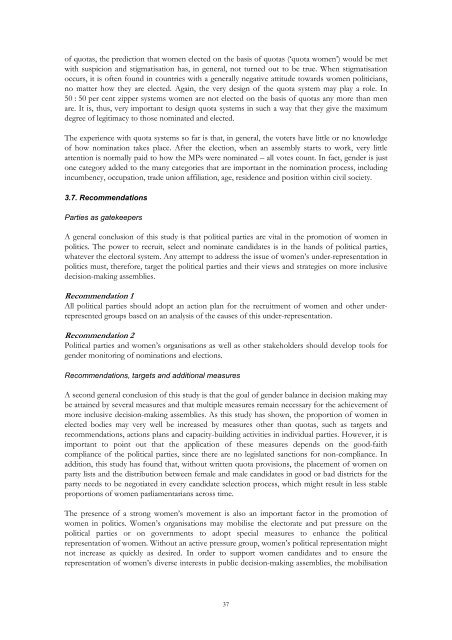proportion of women elected <strong>in</strong> the parliamentary party fractions of all six is higher than the totalproportion of female parliamentarians <strong>in</strong> the respective national parliaments. The biggest differencecan be found <strong>in</strong> the Irish Labour Party, the British Labour Party <strong>and</strong> the NorwegianArbeiderpartiet.Was it difficult to f<strong>in</strong>d a sufficient number of women to st<strong>and</strong> for election under new quota rules,as some critiques of <strong>quotas</strong> predicted? Most of the parties that responded to the PARQUOTASurvey said they had not had difficulty f<strong>in</strong>d<strong>in</strong>g a sufficient number of female c<strong>and</strong>idates, but onethirdagreed that it had been difficult. In general, dur<strong>in</strong>g the course of the historical <strong>in</strong>crease <strong>in</strong> thenumbers of women c<strong>and</strong>idates, parties have been able to f<strong>in</strong>d qualified women, especially if theystarted recruit<strong>in</strong>g a long time before elections rather than at the last m<strong>in</strong>ute. However, at the locallevel there have been reports of a lack of women c<strong>and</strong>idates, even <strong>in</strong> non-quota <strong>systems</strong>. Thegeneral trend is that, ever s<strong>in</strong>ce women ga<strong>in</strong>ed the suffrage, the numbers of female c<strong>and</strong>idates <strong>and</strong>of women elected have gradually <strong>in</strong>creased all over the world. If the parties make serious use of<strong>in</strong>clusive strategies <strong>and</strong> at the same time open up for changes <strong>in</strong> old patriarchal structures, thenthere seem to be few problems with regard to recruit<strong>in</strong>g a balanced number of women <strong>and</strong> men <strong>in</strong>politics.3.6. Quotas <strong>and</strong> the effectiveness of women politiciansIn the quota debate, some fem<strong>in</strong>ist opponents argue that <strong>quotas</strong> do not guarantee more <strong>gender</strong>sensitivelegislation. In contrast, the advocates of <strong>quotas</strong> often express the hope that a greaternumber of women <strong>in</strong> politics will change the male bias of politics. In general, the connectionbetween ‘descriptive’ (percentage) <strong>and</strong> ‘substantial’ (content) representation is a much debated issuewith<strong>in</strong> fem<strong>in</strong>ist research. The focus of this study is descriptive representation – that the politicalassemblies should mirror the population <strong>in</strong> terms of <strong>gender</strong>. However, some remarks concern<strong>in</strong>gthe connection between quota <strong>systems</strong> <strong>and</strong> the effectiveness of elected women politicians willcomplete this analysis.Most studies show that it is women politicians who have placed issues of <strong>gender</strong> equality on thepolitical agenda. Even if women politicians differ as much as male politicians, <strong>and</strong> are usuallydivided between the different political parties along the same l<strong>in</strong>es as men, <strong>their</strong> entry <strong>in</strong>to politicshas changed the political agenda (Wängnerud 2000; Lovenduski 2005a; Lovenduski 2005b).However, the often-heard question ‘Do women <strong>in</strong> politics make a difference?’ may be wronglyposed. An alternative could be: ‘Do men <strong>in</strong> politics make a difference?’.The adoption of <strong>gender</strong>-sensitive policies depends on many factors, such as the strength of thewomen’s movement, the power of equality agencies with<strong>in</strong> the state apparatus, the relative strengthof various political forces, the general debate <strong>in</strong> society about <strong>gender</strong> <strong>and</strong> so on. The very debateabout <strong>in</strong>troduc<strong>in</strong>g <strong>gender</strong> <strong>quotas</strong>, whether they are passed or not, may <strong>in</strong> fact <strong>in</strong>fluence thewill<strong>in</strong>gness of women to st<strong>and</strong> for election (the supply side) as well as the desire of the politicalparties – the gatekeepers to elected positions – to recruit more women (the dem<strong>and</strong> side).For studies of quota <strong>systems</strong>, the specific question to be raised is whether the very design of aquota system hampers the effectiveness of women politicians, once elected, <strong>in</strong> do<strong>in</strong>g <strong>their</strong> job theway they want. This should be studied both <strong>in</strong> a short-term <strong>and</strong> <strong>in</strong> a long-term perspective, <strong>and</strong>,consequently, some conclusions will have to wait until quota <strong>systems</strong> have been <strong>in</strong> operation for alonger period of time.There is obviously a need to develop more elaborate criteria for the evaluation of the effectiveness<strong>and</strong> legitimacy of women elected under different conditions. Historically, women’s movementshave been both supportive of, but also very critical of, women who have been elected. In the case36
of <strong>quotas</strong>, the prediction that women elected on the basis of <strong>quotas</strong> (‘quota women’) would be metwith suspicion <strong>and</strong> stigmatisation has, <strong>in</strong> general, not turned out to be true. When stigmatisationoccurs, it is often found <strong>in</strong> countries with a generally negative attitude towards women politicians,no matter how they are elected. Aga<strong>in</strong>, the very design of the quota system may play a role. In50 : 50 per cent zipper <strong>systems</strong> women are not elected on the basis of <strong>quotas</strong> any more than menare. It is, thus, very important to design quota <strong>systems</strong> <strong>in</strong> such a way that they give the maximumdegree of legitimacy to those nom<strong>in</strong>ated <strong>and</strong> elected.The experience with quota <strong>systems</strong> so far is that, <strong>in</strong> general, the voters have little or no knowledgeof how nom<strong>in</strong>ation takes place. After the election, when an assembly starts to work, very littleattention is normally paid to how the MPs were nom<strong>in</strong>ated – all votes count. In fact, <strong>gender</strong> is justone category added to the many categories that are important <strong>in</strong> the nom<strong>in</strong>ation process, <strong>in</strong>clud<strong>in</strong>g<strong>in</strong>cumbency, occupation, trade union affiliation, age, residence <strong>and</strong> position with<strong>in</strong> civil society.3.7. RecommendationsParties as gatekeepersA general conclusion of this study is that political parties are vital <strong>in</strong> the promotion of women <strong>in</strong>politics. The power to recruit, select <strong>and</strong> nom<strong>in</strong>ate c<strong>and</strong>idates is <strong>in</strong> the h<strong>and</strong>s of political parties,whatever the electoral system. Any attempt to address the issue of women’s under-representation <strong>in</strong>politics must, therefore, target the political parties <strong>and</strong> <strong>their</strong> views <strong>and</strong> strategies on more <strong>in</strong>clusivedecision-mak<strong>in</strong>g assemblies.Recommendation 1All political parties should adopt an action plan for the recruitment of women <strong>and</strong> other underrepresentedgroups based on an analysis of the causes of this under-representation.Recommendation 2Political parties <strong>and</strong> women’s organisations as well as other stakeholders should develop tools for<strong>gender</strong> monitor<strong>in</strong>g of nom<strong>in</strong>ations <strong>and</strong> elections.Recommendations, targets <strong>and</strong> additional measuresA second general conclusion of this study is that the goal of <strong>gender</strong> balance <strong>in</strong> decision mak<strong>in</strong>g maybe atta<strong>in</strong>ed by several measures <strong>and</strong> that multiple measures rema<strong>in</strong> necessary for the achievement ofmore <strong>in</strong>clusive decision-mak<strong>in</strong>g assemblies. As this study has shown, the proportion of women <strong>in</strong>elected bodies may very well be <strong>in</strong>creased by measures other than <strong>quotas</strong>, such as targets <strong>and</strong>recommendations, actions plans <strong>and</strong> capacity-build<strong>in</strong>g activities <strong>in</strong> <strong>in</strong>dividual parties. However, it isimportant to po<strong>in</strong>t out that the application of these measures depends on the good-faithcompliance of the political parties, s<strong>in</strong>ce there are no legislated sanctions for non-compliance. Inaddition, this study has found that, without written quota provisions, the placement of women onparty lists <strong>and</strong> the distribution between female <strong>and</strong> male c<strong>and</strong>idates <strong>in</strong> good or bad districts for theparty needs to be negotiated <strong>in</strong> every c<strong>and</strong>idate selection process, which might result <strong>in</strong> less stableproportions of women parliamentarians across time.The presence of a strong women’s movement is also an important factor <strong>in</strong> the promotion ofwomen <strong>in</strong> politics. Women’s organisations may mobilise the electorate <strong>and</strong> put pressure on thepolitical parties or on governments to adopt special measures to enhance the politicalrepresentation of women. Without an active pressure group, women’s political representation mightnot <strong>in</strong>crease as quickly as desired. In order to support women c<strong>and</strong>idates <strong>and</strong> to ensure therepresentation of women’s diverse <strong>in</strong>terests <strong>in</strong> public decision-mak<strong>in</strong>g assemblies, the mobilisation37
- Page 3 and 4: Directorate-General Internal Polici
- Page 5 and 6: Electoral Gender Quota Systems andT
- Page 8 and 9: AppendicesThe methodology of the qu
- Page 10 and 11: Table 41. Women’s representation
- Page 12 and 13: 1. Mapping of electoral gender quot
- Page 14 and 15: Committee of Ministers’ Recommend
- Page 16 and 17: have occurred after election day -
- Page 18 and 19: parties and take the form of intern
- Page 20 and 21: Knowledge of different electoral qu
- Page 22 and 23: support for female candidates has s
- Page 24 and 25: of more women in politics. Many opp
- Page 26 and 27: Figure 3. The incremental track mod
- Page 28 and 29: is probably that gender quotas rema
- Page 30 and 31: to gender quotas. Likewise, the dat
- Page 32 and 33: ‘Special organisation for women w
- Page 34 and 35: individual parties that adopt them,
- Page 36 and 37: political party in the Swedish Parl
- Page 38 and 39: then the requirement of 50 per cent
- Page 42 and 43: and organisation of women are cruci
- Page 44 and 45: Matland, Richard E., ‘Enhancing W
- Page 46 and 47: Case studyBelgium: a best practice
- Page 48 and 49: While the 1994 act applied to all e
- Page 50 and 51: need to include at least one woman,
- Page 52 and 53: introduced, individual parties adop
- Page 54 and 55: Marissal, Claudie and Hansen, Ingri
- Page 56 and 57: In order to correct the discriminat
- Page 58 and 59: The legal vacuum pertaining to the
- Page 60 and 61: y women in terms of number of seats
- Page 62 and 63: 5. ‘Virtuous dynamic’: the symb
- Page 64 and 65: Case studyGermany: successful quota
- Page 66 and 67: party positions (Gruppenwahlen zu P
- Page 68 and 69: districts, quota rules are often no
- Page 70 and 71: Table 14. Success rates of female a
- Page 72 and 73: Figure 5. Development of the percen
- Page 74 and 75: so far no formal rules have been ad
- Page 76 and 77: Case studyPoland: one step forward,
- Page 78 and 79: 16 in Poland)Rady powiatów(second
- Page 80 and 81: 3. Evaluation3.1. Candidate lists i
- Page 82 and 83: List, in Ozorków Women of Tomorrow
- Page 84 and 85: 3.4. Representation of women in oth
- Page 86 and 87: Case studySlovenia: from voluntary
- Page 88 and 89: council. The positions of candidate
- Page 90 and 91:
3.2.2. The introduction of legislat
- Page 92 and 93:
Table 25 shows that only one of the
- Page 94 and 95:
Source: Author’s own calculation
- Page 96 and 97:
Zakon o volitvah v Evropski parlame
- Page 98 and 99:
Advocates for quotas for women lobb
- Page 100 and 101:
Table 31. The percentage and number
- Page 102 and 103:
Table 33. Municipality elections in
- Page 104 and 105:
Case studySweden: small steps, big
- Page 106 and 107:
40 per cent of either sex on the pa
- Page 108 and 109:
voluntary party quotas than in part
- Page 110 and 111:
The zipper system (50 per cent) int
- Page 112 and 113:
While quotas for minority groups ha
- Page 114 and 115:
Case studyThe United Kingdom: polit
- Page 116 and 117:
In contrast to Labour, the Scottish
- Page 118 and 119:
The twinning and zipping policies a
- Page 120 and 121:
differences across the political pa
- Page 122 and 123:
Appendix IThe methodology of the qu
- Page 124 and 125:
Brigitte Geissel is a political sci
- Page 126:
ZLSDZZPUnited List of Social Democr






